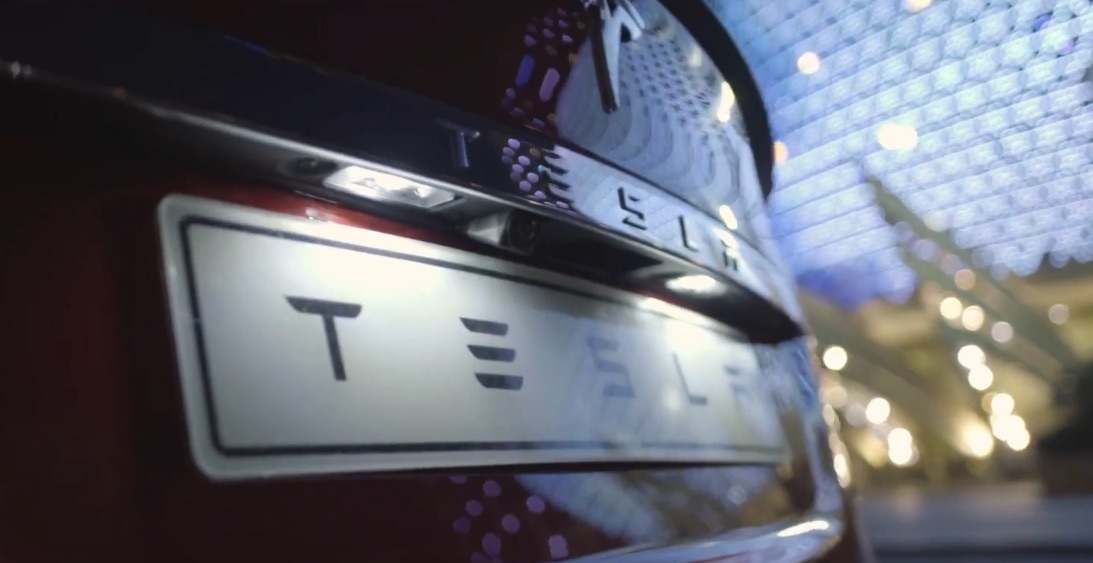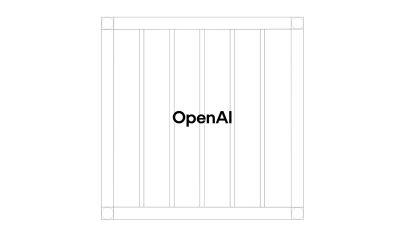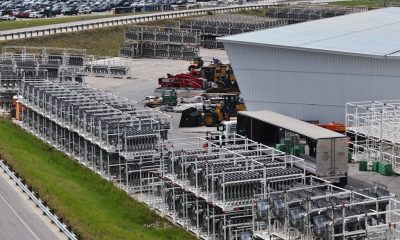

News
Tesla coverage turns negative a week before crucial Earnings Call
Tesla news coverage this week has been especially negative, and the timing of it, which comes a week before arguably the most anticipated Earnings Call in recent memory. With Tesla reporting production and deliveries that were well over Wall Street’s consensus, anticipation for the Q1 2021 Earnings Call is slightly higher than usual, and the FUD (Fear, Uncertainty, Doubt) is at an all-time high.
There are always a few negative Tesla stories every week. It might involve a story about some owners who didn’t receive adequate customer service, it might be about a production bottleneck that Tesla is encountering. However, these are relatively micro-scale issues that are resolved within a matter of days in most cases. This week, the news has been geared toward more disruptive, long-term, macro-level issues, like a very public car accident that has both sides of the Tesla circle butting heads, a test from a very well-known product review company that has to do with the aforementioned accident, and other safety issues that have resulted by a rumored irresponsible driving speed by a customer in China. Whether you agree with it or not, there seems to be a more coordinated attack on something that Tesla does well, which is to keep its drivers and owners safe. One of the strongest points of Tesla’s overwhelmingly successful venture into the automotive industry thus far was the company’s ability to keep vehicle occupants safe in the event of a crash, and also roll out software and semi-autonomous driving functionalities that aim to improve consumer safety in revolutionary ways.
This is a preview of our weekly newsletter. Each week I go ‘Beyond the News’ and handcraft a special edition that includes my thoughts on the biggest stories, why it matters, and how it could impact the future.
This doesn’t always turn out to be what the media wants to report, however. The week before the Q1 Earnings Call, it was relatively impossible to notice that the tide turned negative on Tesla news coverage. While it is understandable that a violent automobile crash that took the lives of two men should be covered, it captured national headlines and dominated news coverage across the world for several days. Interestingly, I don’t remember such widespread news coverage for the Ford Death Wobble.
Journalists find stories and then build upon them for other sorts of coverage. It’s spin-off coverage where readers get to see how creative the mind of a writer is. There are millions of stories that could be written based on the recent automobile accident. However, a majority of them were negative, and it doesn’t necessarily come down to truth, it comes down to perception. Unfortunately, I don’t believe that many of the journalistic coverages were completely accurate simply because of Autopilot’s misunderstood capabilities in the real world. I still receive questions and comments daily from those who I talk to who believe Teslas are capable of driving themselves. What is even more frustrating is that, at times, owners and drivers, who should have the company’s best interest at heart, spread content, Tik Toks, and other forms of social media portraying that their all-electric car can drive them from Point A to Point B while they sit in the back seat and take a nap. This kind of content is irresponsible, immoral, and wrong. Acting like a Tesla can drive itself completely just for few thousand views is a selfish act that puts the hard work of Tesla engineers at risk for losing all of their work.
That brings me to the unfortunate accident in Texas. We don’t know, yet, what the exact cause of the accident was. We don’t know who was in the driver’s seat, if AP was being tricked, or if it was even on at this point. Most evidence would likely indicate that AP couldn’t have been activated due to the lack of road lines, and the rate of travel isn’t something that AP would let the driver do, to begin with. Eventually, we will have all the facts of this story, and we will be able to accurately say who or what was responsible. But as of right now, those things cannot be speculated against.
Still, news sources are claiming that this car was “driverless,” which is a complete nonsensical narrative considering there are many boundaries that would require a driver to be present during the vehicle’s operation. This didn’t stop Consumer Reports from putting together one of the most ridiculously biased tests I have ever come across. I felt that it simply proved Tesla Autopilot would only be tricked in extreme circumstances, by not following the automaker’s directions and trying to outsmart one of the most capable semi-autonomous driving programs in the world.
The obvious effort to derail Tesla’s momentum is being noted by the fans, followers, and owners of the company. For the life of me, I cannot understand why. In my perspective, for years, MSM has been driving home the point of global climate change, using it as a way to scare people into change. While I believe that fear isn’t always the best way to convince a large group of people to do something, I think climate change is a real issue and it will affect people for generations to come. With cars being such a large contributor to the problem, you’d think the media, the same interests that have been preaching the dangers of carbon emissions for years, would report car companies who are working to transition the automotive industry to electrification, would get a “fair shake.” This just hasn’t been the case.
Trust me, I am a critic of Tesla when it is warranted. I have experienced issues with their customer service department personally, and I have been highly critical of their handling of other issues with its vehicles. I have spoken many times about the LR RWD Model Y and how it was a disgrace for Tesla to keep these pre-orderers in limbo for years. However, there are statistics that prove FSD and AP’s ultimate task: to make driving safer. Most recently, the Q1 2021 Safety Report showed Autopilot was nearly 10 times safer than a human driver. You don’t see mainstream media covering this, but you’ll notice automotive blogs and news outlets taking full advantage of the statistics, which prove Tesla’s mission is becoming more real with every mile driven.
With the momentum Tesla posted with the Production and Deliveries report, I think many people were expecting a big financial quarter. The timing of the negative news is eye-opening, and it seems to be a coordinated effort to perhaps slow down Tesla’s momentum moving forward. Tesla is gunning for yet another consecutive quarter, bringing the total to seven straight if things go well on Monday. Whether Wall Street will recognize the impressive tone of this feat, we’ll see. However, media coverage has done all it can to bring Tesla’s chances of a great quarter down, but with developments, demand, and deliveries all in healthy figures, there doesn’t seem to be much of a chance of that happening.
A big thanks to our long-time supporters and new subscribers! Thank you.
I use this newsletter to share my thoughts on what is going on in the Tesla world. If you want to talk to me directly, you can email me or reach me on Twitter. I don’t bite, be sure to reach out!
News
These Tesla, X, and xAI engineers were just poached by OpenAI
The news is the latest in an ongoing feud between Elon Musk and the Sam Altman-run firm OpenAI.

OpenAI, the xAI competitor for which Elon Musk previously served as a boardmember and helped to co-found, has reportedly poached high-level engineers from Tesla, along with others from xAI, X, and still others.
On Tuesday, Wired reported that OpenAI hired four high-level engineers from Tesla, xAI, and X, as seen in an internal Slack message sent by co-founder Greg Brockman. The engineers include Tesla Vice President of Software Engineering David Lau, X and xAI’s head of infrastructure engineering Uday Ruddarraju, and fellow xAI infrastructure engineer Mike Dalton. The hiring spree also included Angela Fan, an AI researcher from Meta.
“We’re excited to welcome these new members to our scaling team,” said Hannah Wong, an OpenAI spokesperson. “Our approach is to continue building and bringing together world-class infrastructure, research, and product teams to accelerate our mission and deliver the benefits of AI to hundreds of millions of people.”
Lau has been in his position as Tesla’s VP of Software Engineering since 2017, after previously working for the company’s firmware, platforms, and system integration divisions.
“It has become incredibly clear to me that accelerating progress towards safe, well-aligned artificial general intelligence is the most rewarding mission I could imagine for the next chapter of my career,” Lau said in a statement to Wired.
🚨Optimistic projections point to xAI possibly attaining profitability by 2027, according to Bloomberg's sources.
If accurate, this would be quite a feat for xAI. OpenAI, its biggest rival, is still looking at 2029 as the year it could become cash flow positive.💰 https://t.co/pE5Z9daez8
— TESLARATI (@Teslarati) June 18, 2025
READ MORE ON OPENAI: Elon Musk’s OpenAI lawsuit clears hurdle as trial looms
At xAI, Ruddarraju and Dalton both played a large role in developing the Colossus supercomputer, which is comprised of over 200,000 GPUs. One of the major ongoing projects at OpenAI is the company’s Stargate program,
“Infrastructure is where research meets reality, and OpenAI has already demonstrated this successfully,” Ruddarraju told Wired in another statement. “Stargate, in particular, is an infrastructure moonshot that perfectly matches the ambitious, systems-level challenges I love taking on.”
Elon Musk is currently in the process of suing OpenAI for shifting toward a for-profit model, as well as for accepting an investment of billions of dollars from Microsoft. OpenAI retaliated with a counterlawsuit, in which it alleges that Musk is interfering with the company’s business and engaging in unfair competition practices.
Elon Musk confirms Grok 4 launch on July 9 with livestream event
News
SpaceX share sale expected to back $400 billion valuation
The new SpaceX valuation would represent yet another record-high as far as privately-held companies in the U.S. go.

A new report this week suggests that Elon Musk-led rocket company SpaceX is considering an insider share sale that would value the company at $400 billion.
SpaceX is set to launch a primary fundraising round and sell a small number of new shares to investors, according to the report from Bloomberg, which cited people familiar with the matter who asked to remain anonymous due to the information not yet being public. Additionally, the company would sell shares from employees and early investors in a follow-up round, while the primary round would determine the price for the secondary round.
The valuation would represent the largest in history from a privately-owned company in the U.S., surpassing SpaceX’s previous record of $350 billion after a share buyback in December. Rivaling company valuations include ByteDance, the parent company of TikTok, as well as OpenAI.
Bloomberg went on to say that a SpaceX representative didn’t respond to a request for comment at the time of publishing. The publication also notes that the details of such a deal could still change, especially depending on interest from the insider sellers and share buyers.
Axiom’s Ax-4 astronauts arriving to the ISS! https://t.co/WQtTODaYfj
— TESLARATI (@Teslarati) June 26, 2025
READ MORE ON SPACEX: SpaceX to decommission Dragon spacecraft in response to Pres. Trump war of words with Elon Musk
SpaceX’s valuation comes from a few different key factors, especially including the continued expansion of the company’s Starlink satellite internet company. According to the report, Starlink accounts for over half of the company’s yearly revenue. Meanwhile, the company produced its 10 millionth Starlink kit last month.
The company also continues to develop its Starship reusable rocket program, despite the company experiencing an explosion of the rocket on the test stand in Texas last month.
The company has also launched payloads for a number of companies and government contracts. In recent weeks, SpaceX launched Axiom’s Ax-4 mission, sending four astronauts to the International Space Station (ISS) for a 14-day stay to work on around 60 scientific experiments. The mission was launched using the SpaceX Falcon 9 rocket and a new Crew Dragon capsule, while the research is expected to span a range of fields including biology, material and physical sciences, and demonstrations of specialized technology.
News
Tesla Giga Texas continues to pile up with Cybercab castings
Tesla sure is gathering a lot of Cybercab components around the Giga Texas complex.

Tesla may be extremely tight-lipped about the new affordable models that it was expected to start producing in the first half of the year, but the company sure is gathering a lot of Cybercab castings around the Giga Texas complex. This is, at least, as per recent images taken of the facility.
Cybercab castings galore
As per longtime drone operator Joe Tegtmeyer, who has been chronicling the developments around the Giga Texas complex for several years now, the electric vehicle maker seems to be gathering hundreds of Cybercab castings around the factory.
Based on observations from industry watchers, the drone operator appears to have captured images of about 180 front and 180 rear Cybercab castings in his recent photos.
Considering the number of castings that were spotted around Giga Texas, it would appear that Tesla may indeed be preparing for the vehicle’s start of trial production sometime later this year. Interestingly enough, large numbers of Cybercab castings have been spotted around the Giga Texas complex in the past few months.
Cybercab production
The Cybercab is expected to be Tesla’s first vehicle that will adopt the company’s “unboxed” process. As per Tesla’s previous update letters, volume production of the Cybercab should start in 2026. So far, prototypes of the Cybercab have been spotted testing around Giga Texas, and expectations are high that the vehicle’s initial trial production should start this year.
With the start of Tesla’s dedicated Robotaxi service around Austin, it might only be a matter of time before the Cybercab starts being tested on public roads as well. When this happens, it would be very difficult to deny the fact that Tesla really does have a safe, working autonomous driving system, and it has the perfect vehicle for it, too.
-

 Elon Musk1 week ago
Elon Musk1 week agoTesla investors will be shocked by Jim Cramer’s latest assessment
-

 News2 weeks ago
News2 weeks agoTesla Robotaxi’s biggest challenge seems to be this one thing
-

 Elon Musk1 day ago
Elon Musk1 day agoElon Musk confirms Grok 4 launch on July 9 with livestream event
-

 News2 weeks ago
News2 weeks agoWatch the first true Tesla Robotaxi intervention by safety monitor
-

 News5 days ago
News5 days agoTesla Model 3 ranks as the safest new car in Europe for 2025, per Euro NCAP tests
-

 Elon Musk2 weeks ago
Elon Musk2 weeks agoA Tesla just delivered itself to a customer autonomously, Elon Musk confirms
-

 Elon Musk2 weeks ago
Elon Musk2 weeks agoxAI welcomes Memphis pollution results, environmental groups push back
-

 Elon Musk2 weeks ago
Elon Musk2 weeks agoElon Musk confirms Tesla Optimus V3 already uses Grok voice AI
















